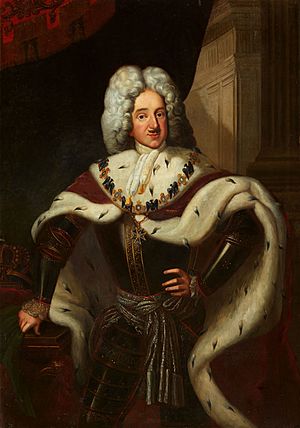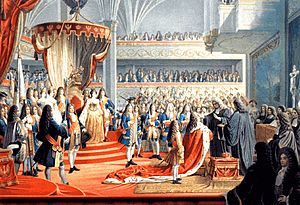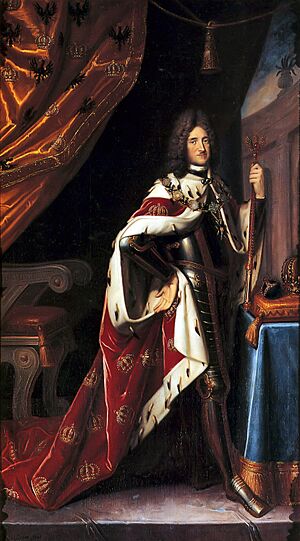Frederick I of Prussia facts for kids
Quick facts for kids Frederick I |
|
|---|---|

King Frederick I in 1701
|
|
| King in Prussia Elector of Brandenburg |
|
| Reign | 18 January 1701 – 25 February 1713 |
| Coronation | 18 January 1701 |
| Successor | Frederick William I |
| Duke of Prussia Elector of Brandenburg |
|
| Reign | 29 April 1688 – 18 January 1701 |
| Predecessor | Frederick William |
| Born | 11 July 1657 Königsberg, Prussia |
| Died | 25 February 1713 (aged 55) Berlin, Prussia, Holy Roman Empire |
| Burial | Berlin Cathedral |
| Spouse | Elizabeth Henrietta of Hesse-Kassel Sophia Charlotte of Hanover Sophia Louise of Mecklenburg-Schwerin |
| Issue | Luise, Hereditary Princess of Hesse-Kassel Prince Frederick August Frederick William I |
| House | Hohenzollern |
| Father | Frederick William, Elector of Brandenburg |
| Mother | Louise Henriette of Orange-Nassau |
| Religion | Calvinist |
| Signature |  |
Frederick I (German: Friedrich I.; 11 July 1657 – 25 February 1713) was an important ruler from the Hohenzollern family. He started as the Elector of Brandenburg and Duke of Prussia. These two areas were ruled together, which is called a personal union. Frederick made history by becoming the first King in Prussia in 1701. He also became the ruler of the Principality of Neuchâtel in 1707.
Contents
Frederick I's Life Story
His Early Life and Family
Frederick was born in Königsberg on July 11, 1657. He was the third son of Frederick William, Elector of Brandenburg. His mother was Louise Henriette of Orange-Nassau. When his father passed away in 1688, Frederick became the Elector of Brandenburg and Duke of Prussia. Soon after, he founded a new city next to Dorotheenstadt and named it Friedrichstadt after himself.
Military Actions and French Culture
Frederick was known for being against France. This was different from his father, who had tried to be friends with King Louis XIV. Frederick joined the League of Augsburg to fight against France. In 1689, he led his army and successfully captured the city of Bonn. Even though he fought against France, he really liked French culture. He tried to make his royal court look like King Louis XIV's court.
Becoming a King
The lands ruled by the Hohenzollern family were known as Brandenburg-Prussia. This included the Margraviate of Brandenburg inside the Holy Roman Empire and the Duchy of Prussia outside of it. Frederick was a Duke and an Elector, but he wanted the more important title of king.
At that time, it was not allowed to have new kingdoms inside the Holy Roman Empire. The only exception was the Kingdom of Bohemia. Frederick talked to Emperor Leopold I about this. He convinced the Emperor to let Prussia become a kingdom. This was agreed in the Crown Treaty in November 1700. In return, Frederick promised to help the Emperor fight against King Louis XIV in the War of the Spanish Succession. He also sent 8,000 Prussian soldiers to help.
Frederick argued that Prussia had never been part of the Holy Roman Empire. He ruled it completely on his own. So, he said there was no reason he couldn't be a king there.
The Coronation and Title
Frederick crowned himself king on January 18, 1701, in Königsberg. The Emperor agreed, and even the King of Poland, Augustus II the Strong, formally recognized him. However, the Polish-Lithuanian Parliament (called the Sejm) did not like this. They thought it was against old agreements.
To show respect for Prussia's past ties to Poland, Frederick agreed to call himself "King in Prussia" instead of "King of Prussia." This meant his royal title applied to Prussia, but he was still an Elector in Brandenburg. Over time, the Emperor's power in Brandenburg became less important. The whole Hohenzollern state was soon treated as one kingdom. Later, his grandson, Frederick the Great, was the first to officially call himself "King of Prussia" in 1772.
Frederick was a big supporter of art and learning. He founded the Prussian Academy of Arts in Berlin in 1696. He also started the Academy of Sciences in 1700. His son later closed the Academy of Sciences to save money, but Frederick the Great reopened it in 1740.
Frederick I passed away in Berlin in 1713. He is buried in the Berliner Dom. His grandson, Frederick the Great, sometimes called him "the mercenary king." This was because Frederick I made a lot of money by renting out his Prussian soldiers to other countries. Frederick the Great also said that his grandfather was "great in small matters, and small in great matters."
Frederick I's Marriages and Children
Frederick was married three times:
- First, he married Elizabeth Henrietta of Hesse-Kassel (1661-1683). They had one daughter:
- Louise Dorothea, born in 1680. She passed away at age 25 without having children.
- Then, he married Sophia Charlotte of Hanover (1668-1705). They had two sons:
- Frederick August (1685–1686)
- Frederick William I, born in 1688, who became king after him.
- In 1708, he married Sophia Louise of Mecklenburg-Schwerin. She lived longer than him, but they did not have any children together.
See also
 In Spanish: Federico I de Prusia para niños
In Spanish: Federico I de Prusia para niños




